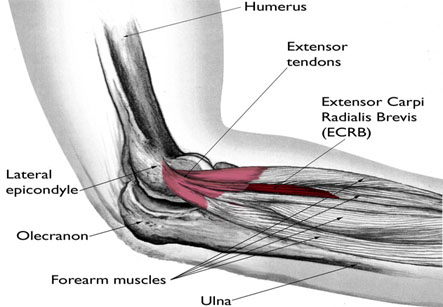Lateral Epicondylitis, Tennis Elbow
Introduction
Tennis elbow, or lateral epicondylitis, is a painful condition of the elbow caused by its overuse. It achieved this name because it can be caused by playing tennis or other racquet sports. However, several other sports and activities can also put the person at risk for this condition.
Tennis elbow is an inflammation of the tendons which join the forearm muscles to the outside of the elbow. The forearm muscles and tendons become damaged as a result of overuse (repeating the same motions again and again). This leads to pain and tenderness on the outer side of the elbow.
There are many treatment options available for tennis elbow. In most cases, treatment involves a combined team approach. Primary physician, physical therapists, and, in some cases, surgeons need to work together to provide the most effective care.
Symptoms
The symptoms of tennis elbow develop gradually. In most cases, they begin as mild pain on the outer side of the elbow which slowly worsens over weeks and months. Even burning sensation can occur. There is usually no specific injury associated with the beginning of symptoms. Weakening of grip strength is associated with pain. Pain can occur on slight movement of forearm in severe cases.
Iran ranks among the top 10 countries in orthopedics and Iranian surgeons perform high quality orthopedic surgeries at highly affordable prices

Cause
Age- Most people who get tennis elbow are between the ages of 30 and 50. In racquet sports like tennis, improper stroke technique and improper equipment may be risk factors.
Overuse- Recent studies show that tennis elbow is often due to damage to a specific forearm muscle. The extensor carpi radialis brevis muscle helps to stabilize the wrist when the elbow is straight. This occurs usually during a tennis groundstroke. When this muscle is weakened from overuse, microscopic tears are formed in the tendon where it attaches to the lateral epicondyle. This leads to inflammation and pain.Repetitive bending and straightening of the elbow causes the muscle to rub against bony bumps. This can cause gradual wear on the muscle over time.
Activities- not only athletes but people who participate in work or recreational activities that require repetitive and vigorous use of the forearm muscles can acquire this condition.
Tests
The doctor may order additional tests to rule out other causes of the symptoms. These are:
X-rays
These may be ordered to rule out arthritis of the elbow.
Magnetic Resonance Imaging (MRI)
If the doctor thinks that the symptoms are related to a neck problem, an MRI scan may be ordered. This will help to diagnose a possible herniated disk or arthritis in the neck. Both these conditions can produce arm pain.
Electromyography (EMG)
An EMG may be ordered to rule out nerve compression. Many nerves travel around the elbow, and the symptoms of nerve compression are often similar to those of tennis elbow.
Nonsurgical (conservative) Treatment:
Approximately 80% to 95% of patients can be successfully treated with nonsurgical treatment. This includes:
• Rest. The first step toward recovery is to give the affected arm proper rest. The patient has to stop participating in sports or heavy work activities for several weeks.
• Non-steroidal anti-inflammatory medicines. Drugs like aspirin or ibuprofen can reduce pain and swelling.
• Exercise of wrist stretching with extended elbow.
• Equipment quality check. If the patient is a participant in a racquet sport, the doctor may advise checking the equipment for proper quality and fit. Stiffer racquets and looser-strung racquets can reduce the stress on the forearm. This means that the forearm muscles do not have to work as hard. If the player uses an oversized racquet, changing to a smaller head may help to prevent symptoms from recurring.
• Physical therapy. Specific exercises for strengthening the muscles of the forearm are advised. The therapist may also perform ultrasonic therapy, ice massage, or muscle-stimulating techniques to improve muscle healing.
• Brace. Using a brace fitted over the back of the forearm may also help to relieve the symptoms of tennis elbow. This acts by resting the muscles and tendons of the forearm.
Surgical Treatment
If the symptoms do not respond or worsen even after 6 to 12 months of nonsurgical treatments, the doctor may recommend surgery.
Surgery for tennis elbow may involve:
1. Cutting or release of the tendon.
2. Removal of inflamed tissue from the tendon.
3. Repairing (reattaching) tendon tears.
Surgery may be done arthroscopically, by traditional open surgery, or by a combination of the two techniques depending on the type of problem and the preference of the doctor.
Surgery can be done with general or regional anesthesia and usually requires an overnight stay in the hospital.
Rehabilitation
Following surgery, the arm may be immobilized temporarily with a splint. About 1 week later, the sutures and splint are removed.